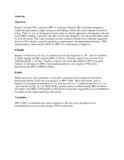| dc.contributor.author | Johnson, Newell W | |
| dc.contributor.author | Dimba, Elisabeth | |
| dc.contributor.author | Chindia, Mark | |
| dc.contributor.author | Njiru, Anthony | |
| dc.contributor.author | D'Lima, Melvin | |
| dc.contributor.author | Wanzala, Peter | |
| dc.contributor.author | Speicher, David J | |
| dc.date.accessioned | 2015-03-24T07:11:44Z | |
| dc.date.available | 2015-03-24T07:11:44Z | |
| dc.date.issued | 2015 | |
| dc.identifier.citation | Speicher, David J., Peter Wanzala, Melvin D'Lima, Anthony Njiru, Mark Chindia, Elisabeth Dimba, and Newell W. Johnson. "Diagnostic challenges of oral and cutaneous Kaposi's sarcoma in resource‐constrained settings." Journal of Oral Pathology & Medicine (2015). | en_US |
| dc.identifier.uri | http://onlinelibrary.wiley.com/doi/10.1111/jop.12315/full | |
| dc.identifier.uri | http://hdl.handle.net/11295/81569 | |
| dc.description.abstract | Abstract
Objectives
Kaposi's sarcoma (KS), caused by HHV-8, is the most frequent HIV-associated malignancy worldwide and remains a major scourge in Sub-Saharan Africa. KS is also endemic in much of Africa. There is a risk of misdiagnosis based solely on clinical appearance and haematoxylin and eosin (H&E) staining, especially with other reactive and neoplastic vascular proliferations which occur in the mouth. This study examined oral and cutaneous biopsies from clinically diagnosed lesions of KS in Kenya, using histopathology supplemented with immunohistochemistry (IHC) and polymerase chain reaction (PCR) for HHV-8 as confirmation of diagnosis.
Methods
Biopsies of 49 lesions (28 oral, 21 cutaneous) previously diagnosed as ‘KS’ were re-examined by H&E staining and IHC targeting HHV-8 LANA-1. Positive controls were sections from embedded BCBL-1 cell lines. Negative controls were from three different HHV-8-negative biopsies. Confirmation of HHV-8 immunohistochemistry was sought by PCR and by determining the HHV-8 ORFK1 subtype.
Results
Whilst most cases were confirmed, 12 oral and 4 cutaneous lesions displayed clinical and histological features of KS but were negative to HHV-8 IHC. These oral lesions were re-diagnosed as pyogenic granulomata (n = 6), deep mycosis (n = 1), inflamed mucosa (n = 2) or ‘uncertain but not KS’ (n = 3). Whilst PCR is usually helpful in differentiating HHV-8 disease, all samples were HHV-8 PCR positive, with identical sequences, suggesting cross-contamination of samples in the original pathology laboratories.
Conclusion
HHV-8 IHC is essential for the correct diagnosis of KS, but due to the high level of contamination in resource-poor settings, PCR is inadvisable. | en_US |
| dc.language.iso | en | en_US |
| dc.title | Diagnostic challenges of oral and cutaneous Kaposi's sarcoma in resource‐constrained settings | en_US |
| dc.type | Article | en_US |
| dc.type.material | en | en_US |

